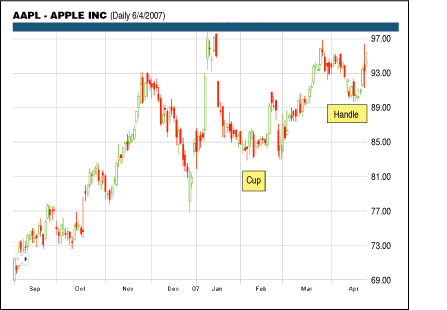Guidelines For A New Classic
Trading The Cup & Handle
by Larry Swing
Cup & handle patterns may be tricky to identify. But if you follow these guidelines you will be able to identify them more easily and accurately.
Although it didn't come from the traditional trading patterns, today the cup & handle pattern is nearly synonymous with the rest of the classics. According to many technical analysts, the classic patterns are the triangle, rectangle, head & shoulders, pennant, flag, double bottom, and double top. These are just a few classical formations that many have come to know.
When William O'Neil, founder of Investor's Business Daily, who turned himself from a modest investor into a multimillionaire, published his book How To Make Money In Stocks, he stated that during his time as an investor, he identified a few price patterns of his own to find successful setups. In his book, he revealed a few of the patterns he identified, coined, and used to make a profit. We've all heard about trading patterns, but very few really know the characteristics, let alone how to trade them. The cup & handle pattern usually forms during the late stages of the bull markets, when corrections tend to be deeper.
IDENTIFYING CUPS & HANDLES
You can see an example of a cup & handle pattern in Figure 1. In many ways, this pattern looks similar to the ascending triangle where if a trendline is drawn from the low of the cup to the low of the handle, it would resemble what you see in Figure 2.

FIGURE 1: A TYPICAL CUP & HANDLE PATTERN. On this daily chart of Apple, Inc. (AAPL), you can clearly see what the cup & handle formation looks like. Note it resembles an ascending triangle.
What are the characteristics of this pattern? A cup & handle can sometimes be taken out of context and labeled as an ascending triangle. To properly qualify as a cup & handle, the cup must be round. There's a strong chance it may have some jagged movement such as what you see in Figure 2, but in general, the length and roundness of the cup is what confirms the formation.
The second factor is that the handle must be shorter in terms of time
and price (see Figure 3). The handle does not necessarily have to be round,
but its formation must be smaller than that of the cup. If the handle is
lower and larger than the cup in width and length, then it is not a cup
& handle formation. For example, the formation of the cup may take
between two to five months, while the handle may take one to two months
to form. As for the prices, in the cup formation the price range should
be at least twice that of the handle's range.
...Continued in the September issue of Technical Analysis of STOCKS
& COMMODITIES
Excerpted from an article originally published in the September 2007
issue of Technical Analysis of STOCKS & COMMODITIES magazine. All rights reserved. © Copyright
2007, Technical Analysis, Inc.
Return to September 2007 Contents